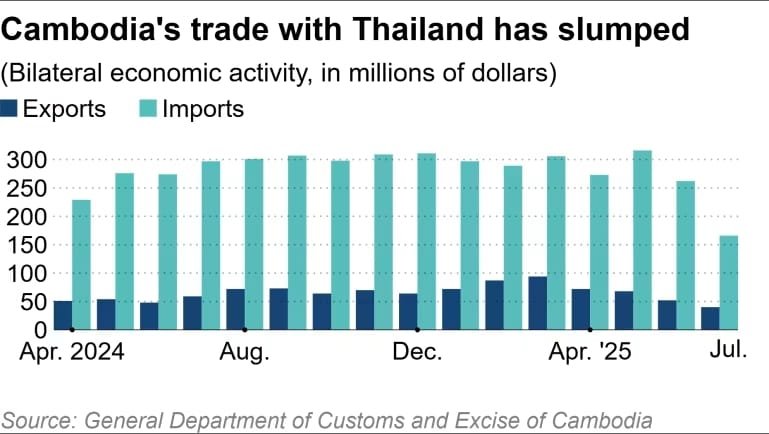For months, the prospect of a Cambodia Border Trade Reopening seemed distant as tensions with Thailand escalated into conflict, severing a critical commerce lifeline. It brought commerce to a near standstill, cutting off vital trade and income for thousands of workers and businesses. At its worst, border trade collapsed to almost zero; just 10 million baht in August 2025, compared to more than 174.5 billion baht in 2024.

Economists estimated that the border shutdown cost Cambodia over 3% of its GDP in 2025. The loss wasn’t just measured in figures—it was felt in households and local markets. Around 750,000 Cambodian workers were forced to return home from Thailand, and the resulting drop in remittances—about US$375 million—hit local economies hard. Small towns that depended on cross-border trade saw spending dry up overnight.
Cambodia Border Trade Reopening: De-escalation Brings Hope
In July 2025, a ceasefire and border de-escalation marked a critical turning point. The reopening of checkpoints began soon after, signaling the start of economic healing. The move is expected to restore trade flows and revive cross-border activity that had nearly vanished just months earlier.
The reopening comes as Cambodia’s broader trade picture strengthens. In the first nine months of 2025, the country recorded a total trade volume of US$46.9 billion, up 14.8% from the previous year. This surge highlights a strong recovery momentum and renewed investor confidence as trade routes stabilize.
Read Also: Can Cambodia Border Trade Restart Heals Old Wounds?
Economic Stakes Run Deep
The stakes in restoring normal border operations are high. Thai investments in Cambodia total about US$3.785 billion, covering sectors from agriculture to manufacturing. More than 62,000 Cambodian workers depend directly on these investments for their livelihoods.
Experts warn that if the border tensions had persisted, Cambodia could have faced monthly trade losses of around 10 billion baht (US$307 million), eroding competitiveness and discouraging new investors. The recent de-escalation and reopening have therefore become essential to preventing deeper economic damage.
Read Also: Cambodia Border Tension Effects on and Investor Fears
Reviving Trade and Local Economies
The Cambodia Border Trade Reopening has given local economies a fresh start. With trade routes restored, trucks are once again crossing the border with agricultural goods, textiles, and industrial materials. Reduced delays and operational costs are helping exporters and importers regain their footing. Local businesses near the border are reporting an uptick in sales and transportation jobs are slowly returning.
Beyond the immediate recovery, the Cambodian government is taking steps to diversify trade routes and strengthen logistics. These efforts aim to make the country less vulnerable to future disruptions like those seen during the border closure. Upgrades in transport infrastructure, warehouse facilities, and customs systems are already underway to ensure smoother trade flows with Thailand and other neighbors.
A Path Toward Sustainable Growth with Cambodia Border Trade Reopening
Talking about the reopening, we are not just talking about numbers. It’s about rebuilding trust, jobs, and resilience. The border conflict highlighted the close connection between regional stability and economic progress. Cambodia’s recovery story now depends on maintaining peace and turning lessons learned into long-term trade strategies.
With the Cambodia Border Trade Reopening, businesses and investors have new reasons to look ahead with optimism. For organizations seeking to understand and leverage these regional shifts, Market Research Cambodia offers global expertise in trade development, investment analysis, and economic strategy. Contact Market Research Cambodia today to explore how your business can benefit from the renewed trade landscape in Southeast Asia.
